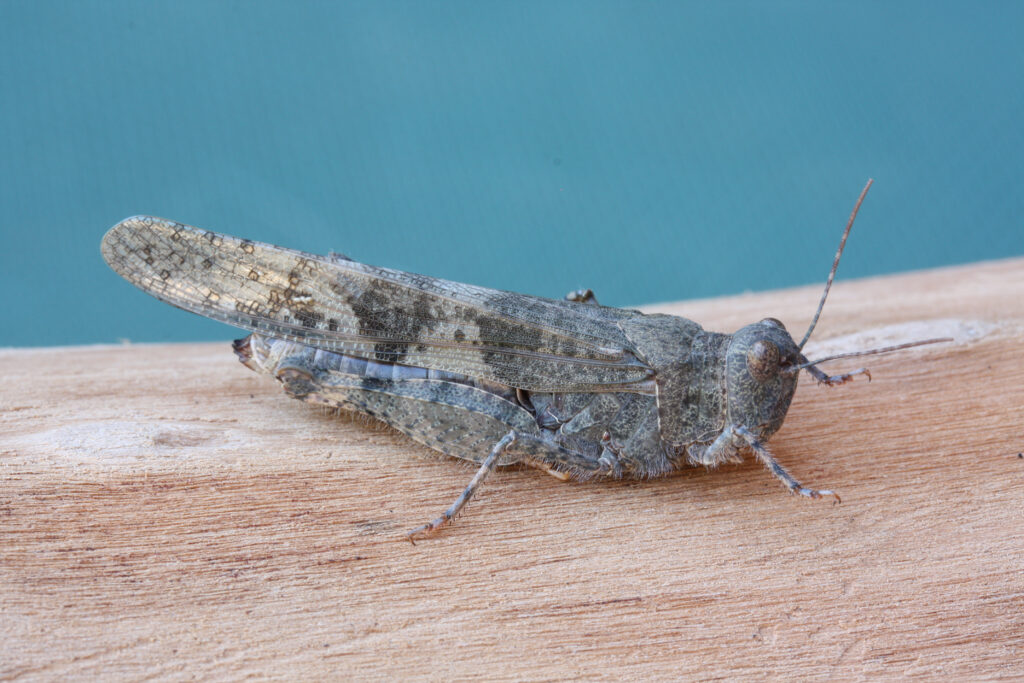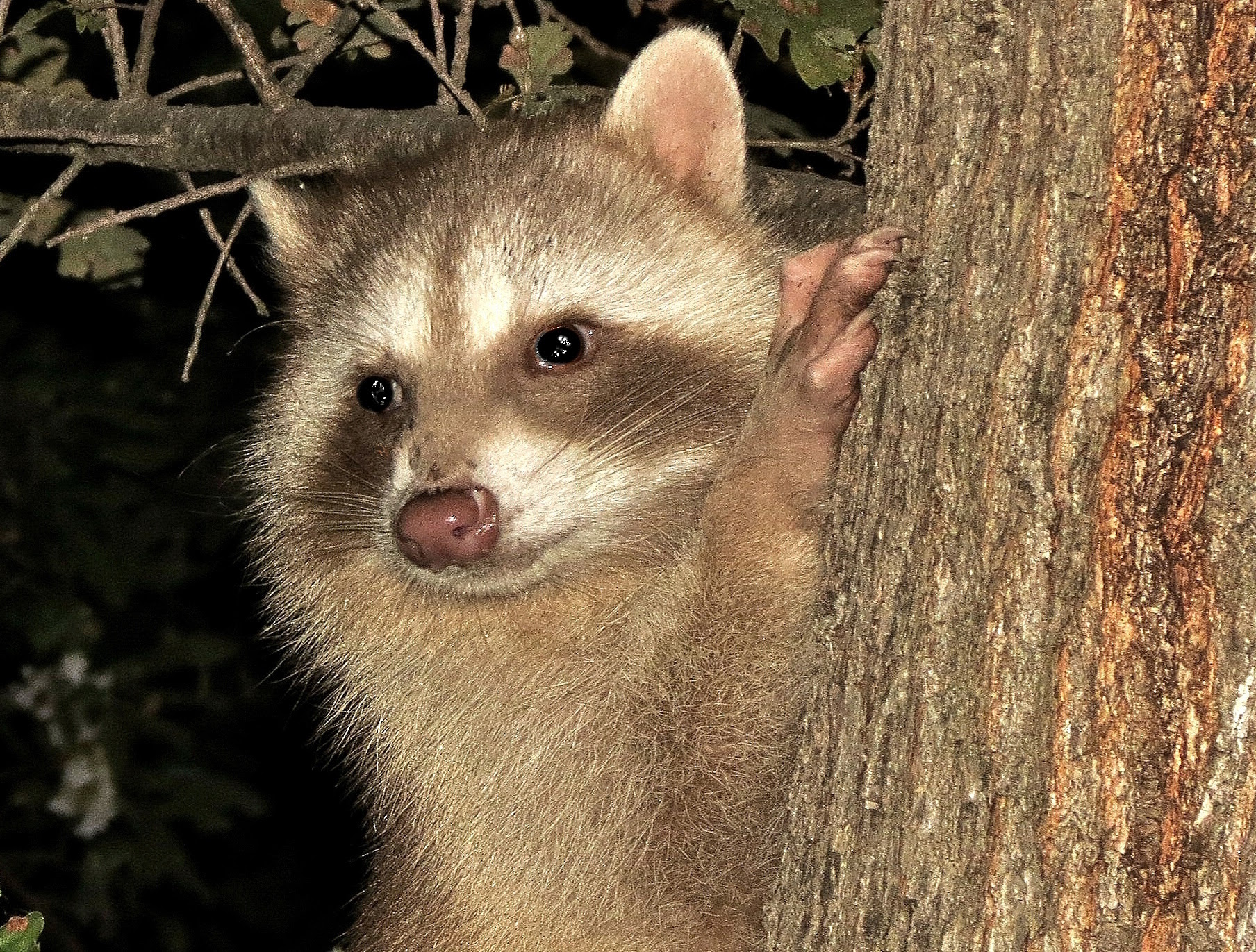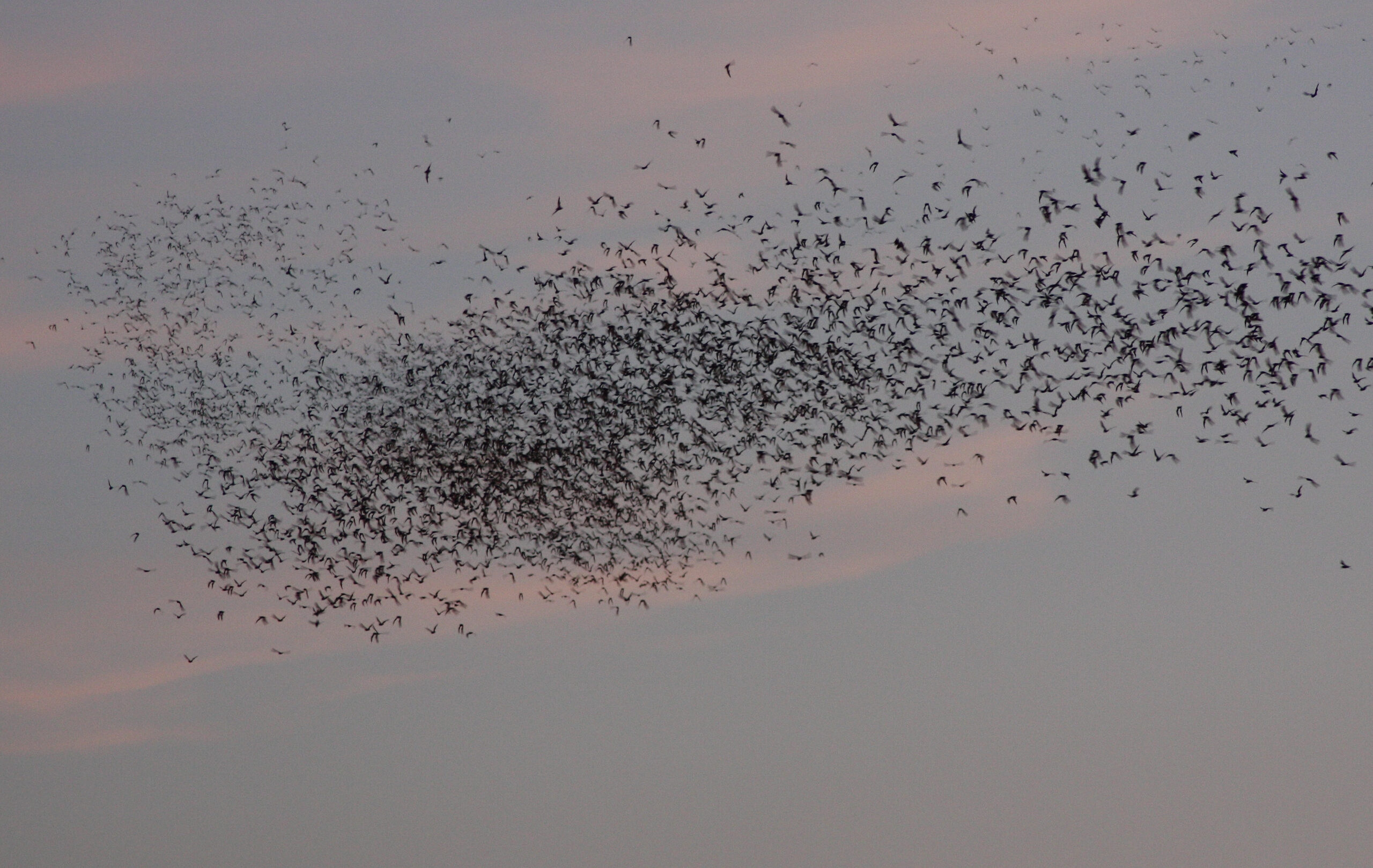You have seen these 1½ inch-long grasshoppers in the Yolo Bypass Wildlife Area, in a vacant lot, or in your backyard. When you startle them, they take flight, making a snapping or cracking sound and exposing a pale yellow patch on their hind wing before landing a few feet away. This is the pallid-winged grasshopper, Trimerotropis pallidipennis, one of the band-winged grasshoppers (the only group of grasshoppers that make this sound in flight). The audible snap they make when they fly is the result of flexing stiff wing membranes, something like a dog training clicker. The noise they make and flash of color from their wings may distract predators, which may try to continue to track the grasshopper’s flight. But the grasshopper simply drops to the ground, seemingly disappearing due to highly effective camouflage. This grasshopper is a common insect of dry habitats, especially if there is bare ground. They are found throughout western North America and in South America from Peru to Argentina. The pallid-winged grasshopper can be especially numerous in deserts. They are more active in the summer and fall and thrive in warm to hot weather. Breeding can take place in temperatures well over 100° F. Eggs hatch after a rest period into nymphs that look like miniature adults without wings. The nymphs pass through a series of molts as they grow before they become winged adults. In warm climates, one to several broods are produced in a year. The pallid-wing grasshopper is a generalist, feeding on many kinds of grasses and forbs (herbaceous flowering plants). It is a strong flier and disperses widely. In the 1960s, a wind-assisted, stray swarm landed in Hawaii and persisted on the islands for two years.
 
Occasionally pallid-winged grasshoppers irrupt (periodic population booms) to very high numbers, but this species is not a true swarming insect; grasshopper species that are truly gregarious and swarm in very large numbers earn the name locust. An example of a true swarming grasshopper is the desert locust, Schistocerca gregaria, perhaps the most notorious insect pest in the world. Normally, it lives a solitary life in low numbers in marginally suitable habitats in areas of North Africa, the Middle East, and Indian subcontinent, and is not an economic threat to agriculture. But when there is a succession of rains that results in a flush of plant growth, the population of desert locusts expands. Then, as unfavorable conditions return, many individuals are forced to crowd into the best remaining habitats. As they become more and more crowded, signals in their brains trigger dramatic changes in their metabolism and behavior. They breed often, become gregarious, and develop long wings, enabling them to fly fast and far. A pheromone is released by the insects that causes them to be mutually attracted. Now they may form locust plagues, invading new areas and consuming all the vegetation in their path, including crops. A single swarm might be 400 square miles or more and can contain 100 million or more locusts per square mile (a total of 40 billion locusts per swarm). The swarm may fly up to 90 miles in a day in the direction of the prevailing winds. In a single day, a very small swarm of about a third of a square mile eats the equivalent amount of food consumed daily by 35,000 people (United Nations Food and Agriculture Organization (FAO)). Each locust can live between 3 and 6 months. Locust plagues are not a historical footnote. In the last 100 years, there have been seven desert locust plagues, the most recent in 2019-2021, resulting in food insecurity for people living in the Horn of Africa and beyond. The FAO monitors the potential for swarming by the desert locust on a daily basis. This information is available at www.fao.org/ag/locusts/en/info/info/index.html.North America once had a locust that swarmed in numbers far larger than swarms of the desert locust, and possibly larger than any known locust species. In 1875, an observer named A.L. Child estimated a swarm of the Rocky Mountain locust (Melanoplus spretus) at 198,000 square miles in size (far bigger than the area of California). It might have consisted of trillions of insects. For a fascinating read of many accounts of swarms of this locust on both sides of the Rocky Mountains, including the details behind Child’s estimate of the size of the 1875 swarm (in his own words), see the Second Report of the United States Entomological Commission, published by the Department of the Interior in 1880. Peak swarms of the Rocky Mountain locust may have consumed as much forage as the American bison in its heyday. Shockingly, by 1902 or shortly thereafter, the locust was extinct. Today, North America has no swarming locusts. The High Plains locust used to swarm but it is now a rare species. The Rocky Mountain locust is known from many specimens in the Grasshopper Glacier in Montana. The glacier has or had (it’s melting fast) tens of millions of grasshoppers, including the Rocky Mountain locust, entombed in the ice, apparently caught in snowstorms long ago. The reason for the quick disappearance of the locust is a mystery. Apparently, it descended from the Rocky Mountains to the tall-grass prairie, where it laid eggs during swarming, although it wasn’t adapted to the prairie. Instead, permanent breeding grounds may have been river valleys in the Rocky Mountains. Those valleys were probably among the first sites put under the plow by settlers. The devastation of beaver populations for the fur trade also altered natural ecosystems that might have been critical to successful breeding of the locust. The transformation of the tall grass prairie into plowed ground may have played a role in the locust’s demise as well. Perhaps the Rocky Mountain locust co-evolved with bison, and somehow benefited from it on the prairie. Maybe a combination of these factors caused the fabric of its ecosystem to unravel within a very short amount of time. One confounding consideration is the apparent prime habitat for the locust in the Yellowstone area, which was never farmed and remained intact. In any case, the disappearance of the Rocky Mountain locust, possibly among the most abundant of all animals on the planet, remains a mystery.It is astonishing how changes in an ecosystem, even changes of short durations, can alter the course of life. Grasshoppers exhibit the two ends of the spectrum of an altered habitat—a population explosion of terrifying proportions on one hand and extinction on the other. Our well-mannered pallid-winged grasshopper of the Bypass is adaptable to a variety of habitats and might be highly resilient to a quickly changing, warming world. Are we? |






